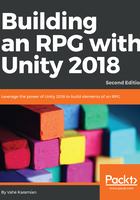
What this book covers
Chapter 1, What is an RPG?, provides a good background of what an RPG is. It covers some historical aspects and gives examples of existing RPGs. It discuss the main aspects of an RPG, covers some terminology, and prepares the reader for the rest of the book.
Chapter 2, Planning the Game, is where we take a look at character definitions, character class attributes, character states, and how to set up and rig character models, which includes an exploration of motion, controllers, and inverse kinematics.
Chapter 3, RPG Character Design, continues expanding on player character customization and looks at preserving character states, the setup of Non-Player Characters (NPCs), and introducing NPC Artificial Intelligence (AI) and interaction.
Chapter 4, The Game Mechanics, is where we start planning the game. We discuss the different types of assets and resources we will need during the creation of our game, introduce a third-person character controller, and create our initial level and scripts. We also take a look at the Terrain Toolkit for terrain generation.
Chapter 5, GameMaster and Game Mechanics, looks at enhancing the Game Master script, introduces Level Controller and Audio Controller scripts, discusses the storage of character data and the character customization state, and explores options for the initial user interface for the main menu.
Chapter 6, Inventory System, covers the creation of a generic inventory system; the creation of the necessary scripts, assets, and prefabs that represent the inventory items; designing the inventory user interface; and how to represent the inventory system and its items.
Chapter 7, User Interface and System Feedback, discusses the design and implementation of a heads-up display, player character information panel, and the active inventory items panel. The special inventory items panel is designed and implemented, as are the non-player character health bar and UI.
Chapter 8, Multiplayer Setup, discusses multiplayer programming using Unity's Unet architecture. This chapter illustrates the concepts using two sample projects. The initial project is a tank game that illustrates the concepts of server client and data synchronization. The second project applies what we have learned to create a scene supporting our character models.